Ruiqi Wu
Active Intelligence in Video Avatars via Closed-loop World Modeling
Dec 23, 2025Abstract:Current video avatar generation methods excel at identity preservation and motion alignment but lack genuine agency, they cannot autonomously pursue long-term goals through adaptive environmental interaction. We address this by introducing L-IVA (Long-horizon Interactive Visual Avatar), a task and benchmark for evaluating goal-directed planning in stochastic generative environments, and ORCA (Online Reasoning and Cognitive Architecture), the first framework enabling active intelligence in video avatars. ORCA embodies Internal World Model (IWM) capabilities through two key innovations: (1) a closed-loop OTAR cycle (Observe-Think-Act-Reflect) that maintains robust state tracking under generative uncertainty by continuously verifying predicted outcomes against actual generations, and (2) a hierarchical dual-system architecture where System 2 performs strategic reasoning with state prediction while System 1 translates abstract plans into precise, model-specific action captions. By formulating avatar control as a POMDP and implementing continuous belief updating with outcome verification, ORCA enables autonomous multi-step task completion in open-domain scenarios. Extensive experiments demonstrate that ORCA significantly outperforms open-loop and non-reflective baselines in task success rate and behavioral coherence, validating our IWM-inspired design for advancing video avatar intelligence from passive animation to active, goal-oriented behavior.
Astraea: A State-Aware Scheduling Engine for LLM-Powered Agents
Dec 16, 2025Abstract:Large Language Models (LLMs) are increasingly being deployed as intelligent agents. Their multi-stage workflows, which alternate between local computation and calls to external network services like Web APIs, introduce a mismatch in their execution pattern and the scheduling granularity of existing inference systems such as vLLM. Existing systems typically focus on per-segment optimization which prevents them from minimizing the end-to-end latency of the complete agentic workflow, i.e., the global Job Completion Time (JCT) over the entire request lifecycle. To address this limitation, we propose Astraea, a service engine designed to shift the optimization from local segments to the global request lifecycle. Astraea employs a state-aware, hierarchical scheduling algorithm that integrates a request's historical state with future predictions. It dynamically classifies requests by their I/O and compute intensive nature and uses an enhanced HRRN policy to balance efficiency and fairness. Astraea also implements an adaptive KV cache manager that intelligently handles the agent state during I/O waits based on the system memory pressure. Extensive experiments show that Astraea reduces average JCT by up to 25.5\% compared to baseline methods. Moreover, our approach demonstrates strong robustness and stability under high load across various model scales.
Continual Retinal Vision-Language Pre-training upon Incremental Imaging Modalities
Jun 24, 2025Abstract:Traditional fundus image analysis models focus on single-modal tasks, ignoring fundus modality complementarity, which limits their versatility. Recently, retinal foundation models have emerged, but most still remain modality-specific. Integrating multiple fundus imaging modalities into a single foundation model is valuable. However, in dynamic environments, data from different modalities often arrive incrementally, necessitating continual pre-training. To address this, we propose RetCoP, the first continual vision-language pre-training framework in the fundus domain, which incrementally integrates image and text features from different imaging modalities into a single unified foundation model. To mitigate catastrophic forgetting in continual pre-training, we introduce a rehearsal strategy utilizing representative image-text pairs and an off-diagonal information distillation approach. The former allows the model to revisit knowledge from previous stages, while the latter explicitly preserves the alignment between image and text representations. Experiments show that RetCoP outperforms all the compared methods, achieving the best generalization and lowest forgetting rate. The code can be found at https://github.com/Yuang-Yao/RetCoP.
DIPO: Dual-State Images Controlled Articulated Object Generation Powered by Diverse Data
May 28, 2025Abstract:We present DIPO, a novel framework for the controllable generation of articulated 3D objects from a pair of images: one depicting the object in a resting state and the other in an articulated state. Compared to the single-image approach, our dual-image input imposes only a modest overhead for data collection, but at the same time provides important motion information, which is a reliable guide for predicting kinematic relationships between parts. Specifically, we propose a dual-image diffusion model that captures relationships between the image pair to generate part layouts and joint parameters. In addition, we introduce a Chain-of-Thought (CoT) based graph reasoner that explicitly infers part connectivity relationships. To further improve robustness and generalization on complex articulated objects, we develop a fully automated dataset expansion pipeline, name LEGO-Art, that enriches the diversity and complexity of PartNet-Mobility dataset. We propose PM-X, a large-scale dataset of complex articulated 3D objects, accompanied by rendered images, URDF annotations, and textual descriptions. Extensive experiments demonstrate that DIPO significantly outperforms existing baselines in both the resting state and the articulated state, while the proposed PM-X dataset further enhances generalization to diverse and structurally complex articulated objects. Our code and dataset will be released to the community upon publication.
Iterative Predictor-Critic Code Decoding for Real-World Image Dehazing
Mar 17, 2025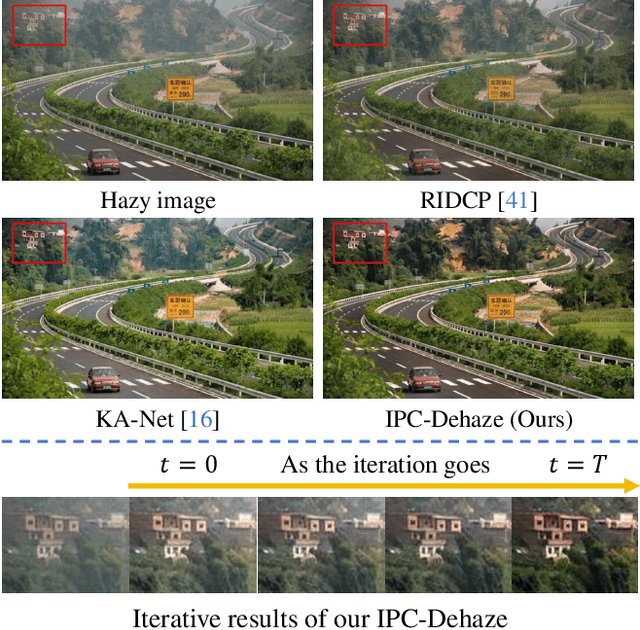
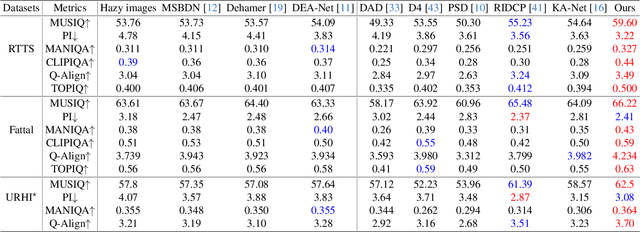
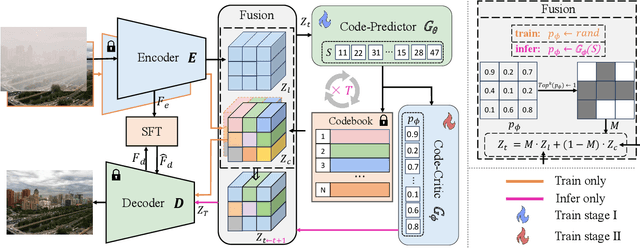

Abstract:We propose a novel Iterative Predictor-Critic Code Decoding framework for real-world image dehazing, abbreviated as IPC-Dehaze, which leverages the high-quality codebook prior encapsulated in a pre-trained VQGAN. Apart from previous codebook-based methods that rely on one-shot decoding, our method utilizes high-quality codes obtained in the previous iteration to guide the prediction of the Code-Predictor in the subsequent iteration, improving code prediction accuracy and ensuring stable dehazing performance. Our idea stems from the observations that 1) the degradation of hazy images varies with haze density and scene depth, and 2) clear regions play crucial cues in restoring dense haze regions. However, it is non-trivial to progressively refine the obtained codes in subsequent iterations, owing to the difficulty in determining which codes should be retained or replaced at each iteration. Another key insight of our study is to propose Code-Critic to capture interrelations among codes. The Code-Critic is used to evaluate code correlations and then resample a set of codes with the highest mask scores, i.e., a higher score indicates that the code is more likely to be rejected, which helps retain more accurate codes and predict difficult ones. Extensive experiments demonstrate the superiority of our method over state-of-the-art methods in real-world dehazing.
SeCap: Self-Calibrating and Adaptive Prompts for Cross-view Person Re-Identification in Aerial-Ground Networks
Mar 10, 2025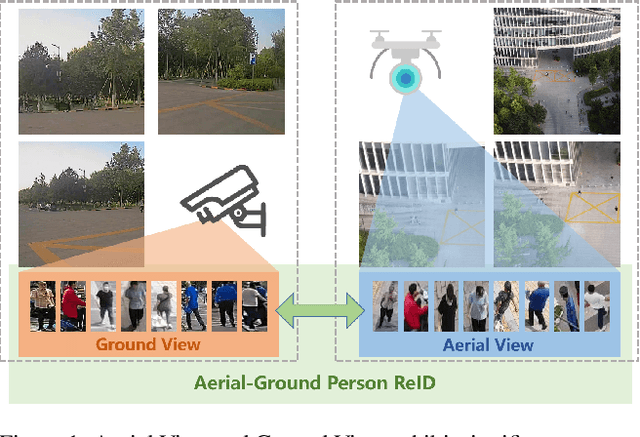
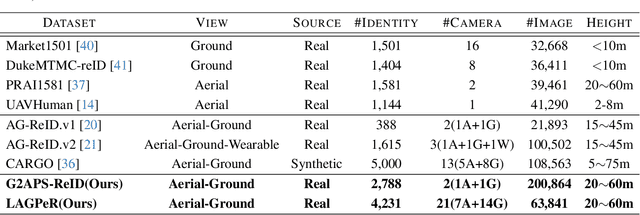
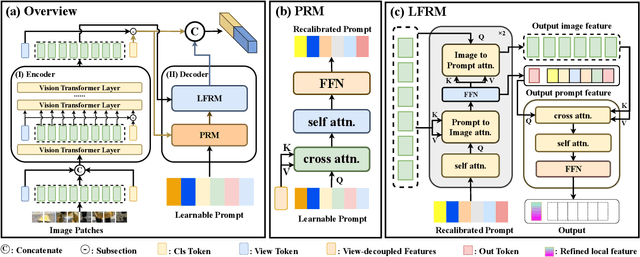

Abstract:When discussing the Aerial-Ground Person Re-identification (AGPReID) task, we face the main challenge of the significant appearance variations caused by different viewpoints, making identity matching difficult. To address this issue, previous methods attempt to reduce the differences between viewpoints by critical attributes and decoupling the viewpoints. While these methods can mitigate viewpoint differences to some extent, they still face two main issues: (1) difficulty in handling viewpoint diversity and (2) neglect of the contribution of local features. To effectively address these challenges, we design and implement the Self-Calibrating and Adaptive Prompt (SeCap) method for the AGPReID task. The core of this framework relies on the Prompt Re-calibration Module (PRM), which adaptively re-calibrates prompts based on the input. Combined with the Local Feature Refinement Module (LFRM), SeCap can extract view-invariant features from local features for AGPReID. Meanwhile, given the current scarcity of datasets in the AGPReID field, we further contribute two real-world Large-scale Aerial-Ground Person Re-Identification datasets, LAGPeR and G2APS-ReID. The former is collected and annotated by us independently, covering $4,231$ unique identities and containing $63,841$ high-quality images; the latter is reconstructed from the person search dataset G2APS. Through extensive experiments on AGPReID datasets, we demonstrate that SeCap is a feasible and effective solution for the AGPReID task. The datasets and source code available on https://github.com/wangshining681/SeCap-AGPReID.
MM-Retinal V2: Transfer an Elite Knowledge Spark into Fundus Vision-Language Pretraining
Jan 27, 2025



Abstract:Vision-language pretraining (VLP) has been investigated to generalize across diverse downstream tasks for fundus image analysis. Although recent methods showcase promising achievements, they significantly rely on large-scale private image-text data but pay less attention to the pretraining manner, which limits their further advancements. In this work, we introduce MM-Retinal V2, a high-quality image-text paired dataset comprising CFP, FFA, and OCT image modalities. Then, we propose a novel fundus vision-language pretraining model, namely KeepFIT V2, which is pretrained by integrating knowledge from the elite data spark into categorical public datasets. Specifically, a preliminary textual pretraining is adopted to equip the text encoder with primarily ophthalmic textual knowledge. Moreover, a hybrid image-text knowledge injection module is designed for knowledge transfer, which is essentially based on a combination of global semantic concepts from contrastive learning and local appearance details from generative learning. Extensive experiments across zero-shot, few-shot, and linear probing settings highlight the generalization and transferability of KeepFIT V2, delivering performance competitive to state-of-the-art fundus VLP models trained on large-scale private image-text datasets. Our dataset and model are publicly available via https://github.com/lxirich/MM-Retinal.
Enhancing Visible-Infrared Person Re-identification with Modality- and Instance-aware Visual Prompt Learning
Jun 18, 2024



Abstract:The Visible-Infrared Person Re-identification (VI ReID) aims to match visible and infrared images of the same pedestrians across non-overlapped camera views. These two input modalities contain both invariant information, such as shape, and modality-specific details, such as color. An ideal model should utilize valuable information from both modalities during training for enhanced representational capability. However, the gap caused by modality-specific information poses substantial challenges for the VI ReID model to handle distinct modality inputs simultaneously. To address this, we introduce the Modality-aware and Instance-aware Visual Prompts (MIP) network in our work, designed to effectively utilize both invariant and specific information for identification. Specifically, our MIP model is built on the transformer architecture. In this model, we have designed a series of modality-specific prompts, which could enable our model to adapt to and make use of the specific information inherent in different modality inputs, thereby reducing the interference caused by the modality gap and achieving better identification. Besides, we also employ each pedestrian feature to construct a group of instance-specific prompts. These customized prompts are responsible for guiding our model to adapt to each pedestrian instance dynamically, thereby capturing identity-level discriminative clues for identification. Through extensive experiments on SYSU-MM01 and RegDB datasets, the effectiveness of both our designed modules is evaluated. Additionally, our proposed MIP performs better than most state-of-the-art methods.
* Accepyed by ACM International Conference on Multimedia Retrieval (ICMR'24)
Auto-selected Knowledge Adapters for Lifelong Person Re-identification
May 30, 2024



Abstract:Lifelong Person Re-Identification (LReID) extends traditional ReID by requiring systems to continually learn from non-overlapping datasets across different times and locations, adapting to new identities while preserving knowledge of previous ones. Existing approaches, either rehearsal-free or rehearsal-based, still suffer from the problem of catastrophic forgetting since they try to cram diverse knowledge into one fixed model. To overcome this limitation, we introduce a novel framework AdalReID, that adopts knowledge adapters and a parameter-free auto-selection mechanism for lifelong learning. Concretely, we incrementally build distinct adapters to learn domain-specific knowledge at each step, which can effectively learn and preserve knowledge across different datasets. Meanwhile, the proposed auto-selection strategy adaptively calculates the knowledge similarity between the input set and the adapters. On the one hand, the appropriate adapters are selected for the inputs to process ReID, and on the other hand, the knowledge interaction and fusion between adapters are enhanced to improve the generalization ability of the model. Extensive experiments are conducted to demonstrate the superiority of our AdalReID, which significantly outperforms SOTAs by about 10$\sim$20\% mAP on both seen and unseen domains.
MM-Retinal: Knowledge-Enhanced Foundational Pretraining with Fundus Image-Text Expertise
May 20, 2024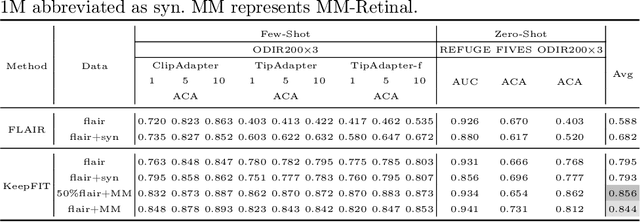


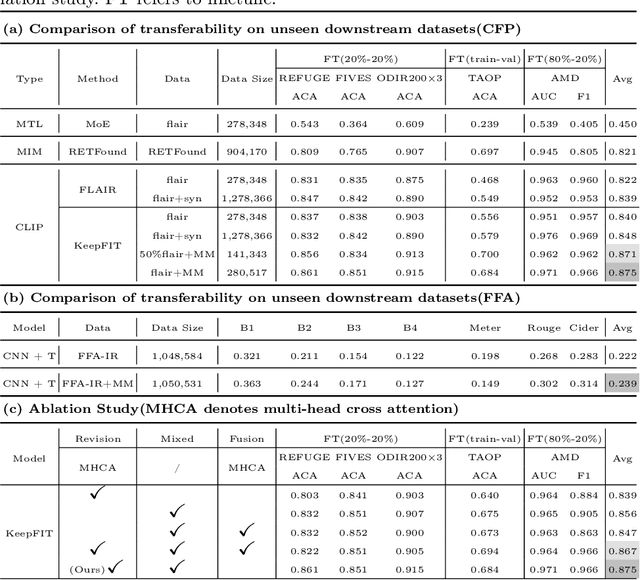
Abstract:Current fundus image analysis models are predominantly built for specific tasks relying on individual datasets. The learning process is usually based on data-driven paradigm without prior knowledge, resulting in poor transferability and generalizability. To address this issue, we propose MM-Retinal, a multi-modal dataset that encompasses high-quality image-text pairs collected from professional fundus diagram books. Moreover, enabled by MM-Retinal, we present a novel Knowledge-enhanced foundational pretraining model which incorporates Fundus Image-Text expertise, called KeepFIT. It is designed with image similarity-guided text revision and mixed training strategy to infuse expert knowledge. Our proposed fundus foundation model achieves state-of-the-art performance across six unseen downstream tasks and holds excellent generalization ability in zero-shot and few-shot scenarios. MM-Retinal and KeepFIT are available at https://github.com/lxirich/MM-Retinal.
 Add to Chrome
Add to Chrome Add to Firefox
Add to Firefox Add to Edge
Add to Edge